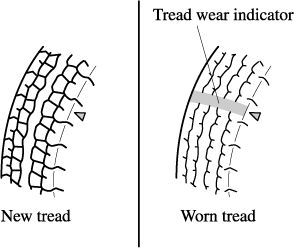Owner Maintenance Precautions
Bonnet
Engine Compartment Overview
Engine Oil
Engine Coolant
Brake/Clutch Fluid
Window Washer Fluid
Body Lubrication
Wiper Blades
Battery
Key Battery Replacement
Tyres
Light Bulbs
Fuses
Emission Control Maintenance (Australia)
Replacing a Tyre
Always use tyres that are in good condition:
Driving with worn tyres is dangerous. Reduced braking, steering, and traction could result in an accident.
Replace all four tyres at the same time:
Replacing just one tyre is dangerous. It could cause poor handling and poor braking resulting in loss of vehicle control. Mazda strongly recommends that you replace all four tyres at the same time.
Close Warning

View Warning

If a tyre wears evenly, a wear indicator will appear as a solid band across the tread.
Replace the tyre when this happens.

You should replace the tyre before the band crosses the entire tread.


 Read this first
Read this first



















